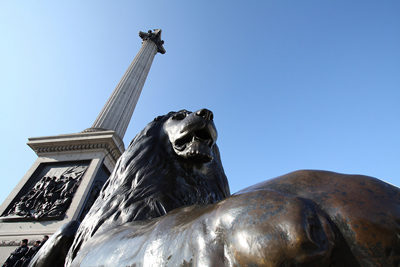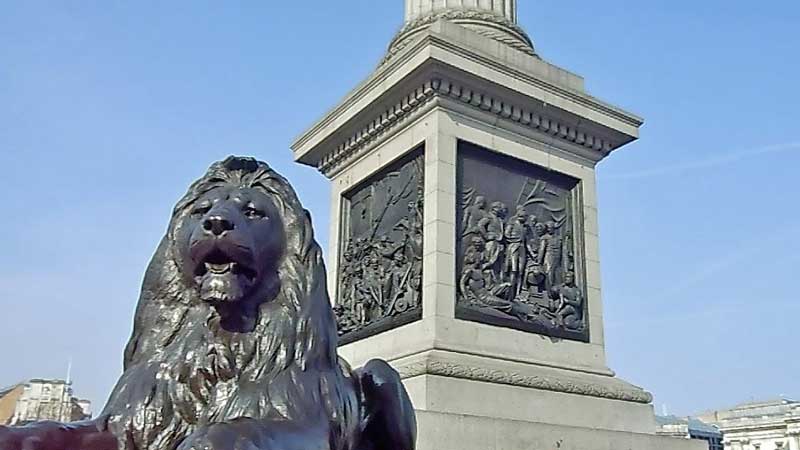
Constructed between 1840 and 1843 to a design by William Railton, the Nelson Column stands tall in Trafalgar Square in central London. It was erected to commemorate Admiral Horatio Nelson's victory at the Battle of Trafalgar in 1805, a victory in which he died. Nelson, a British flag officer in the Royal Navy, was noted for his inspirational leadership, grasp of strategy and unconventional tactics, which together resulted in a number of decisive British naval victories, particularly during the Napoleonic Wars. He was wounded several times in combat, lost the sight in one eye in Corsica and most of one arm in the unsuccessful attempt to conquer Santa Cruz de Tenerife. Finally, he was shot and killed during his final victory at the Battle of Trafalgar in 1805.
The Nelson’s column of the Corinthian order was built from Dartmoor granite and the Craigleith sandstone statue of Nelson, standing on the top of the column, was crafted by the English sculptor Edward Hodges Baily. The four bronze relief panels, each measuring 5.5 m (18 feet) square, decorating the pedestal, were cast from the captured French guns. They depict the Battle of Cape St Vincent, the Battle of the Nile, the Battle of Copenhagen and the tragic death of Nelson at Trafalgar. From the bottom of the pedestal to the top of Nelson's hat, the whole monument is 51.6 m (169 ft 3 in) tall.

The plan to construct a memorial of Nelson started as early as in February 1838, when a group of 121 peers, MPs and other gentry formed a committee to raise a monument funded by public subscription. The Government readily agreed to the proposal and also promised to provide a site in Trafalgar Square, in front of the newly completed National Gallery. A competition was arranged for the selection of a design with an estimated budget of between £20,000 and £30,000. Originally, the design submitted by William Railton was chosen by the sub-committee headed by the Duke of Wellington and the second prize was won by Edward Hodges Baily.
However, due to the criticism of the organisation of the competition caused it to be re-run and the slightly revised design of Railton was declared the winner, with the condition that the statue of Nelson should be made by EH Baily. Originally it was planned that, the column would be 62 m (203 feet) tall, including the base and statue. But this was reduced to 52 m (170 feet), with a shaft of 30 m (98 feet) due to concerns over stability. The base was supposed to be made of granite and the shaft of Craigleith sandstone, but before the beginning of the construction it was decided that the shaft should also be of granite.


Work for the brick foundations had begun by July 1840 and the first stone of the column was laid on 30 September 1840. However, the Government took over the project, as the Nelson Memorial Committee ran out of money in 1844. Installation of the bronze reliefs on the pedestal was delayed and did not begin until late 1849. During the casting of the last relief depicting the Battle of Cape St Vincent it was discovered that the bronze had been adulterated with iron. The responsible partners in the relative company were jailed for fraud and the relief was completed by Robinson and Cottam and finally put in place in May 1854. Commissioned in 1858, the four identical bronze Barbary lions at the column's base were designed by Sir Edwin Landseer in collaboration with Baron Marochetti and were added in 1867.

In 2006, the column was scaffolded from top to bottom and was refurbished by steam cleaning, together with gentle abrasives. In December 2015, Disney paid £24,000 to cover it in lights to make it resemble a giant ‘lightsaber’, to promote their exciting film ‘Star Wars: The force’.